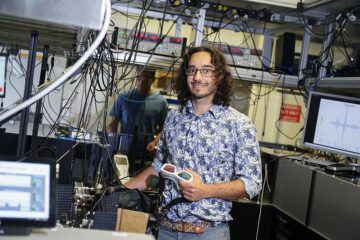MSU team discovers gene mutations that cause hearing loss

Michigan State University researchers have discovered a set of gene mutations that cause progressive hearing loss, a discovery that should provide significant clues in the hunt to solve the puzzle of acquired hearing loss.
The research, which was led by faculty from the MSU Hearing Research Center, will be published in the November issue of the American Journal of Human Genetics.
The gene involved, known as DFNA 20, is known to play an essential role in the structure of the inner ear, the cochlea. It’s one of nearly 100 genes known to play a role in hearing loss.
“Until now, no mutations had been discovered in this gene, so this finding is expected to provide new insights that will help researchers understand more about the biology of progressive loss,” said Rachel Fisher, director of the MSU Hearing Research Center and one of the project leaders. “One possibility is that the mutations interfere with processes that allow ears to repair damage done by noise or aging.”
As with any health threat, early detection is the key to proper care.
“Knowing what the gene is means that you can maybe move toward preventing hearing loss or, possibly, curing it,” said Karen Friderici, an MSU associate professor of microbiology and molecular genetics, whose laboratory identified the gene.
An estimated 28 million Americans, including one in three over the age of 60, have hearing loss. Unfortunately, very little is known about how the hearing mechanism ages.
This research began in Michigan about six years ago with members of a family who reported the onset of hearing-related communication problems as they neared the age of 30. The project eventually led Fisher and her colleagues to Cornwall, England, where, by looking through census data, they found that this family had hearing problems as far back as 1800.
These findings are already benefiting the families involved in the project, said Jill Elfenbein, an MSU associate professor of audiology and speech sciences and a team member.
“The grandmother in Michigan who initiated contact with MSU now has the satisfaction that we have identified the cause of the hearing loss that affects approximately half of her descendants,” she said. “For the youngest of her grandchildren, there is the potential that 20 years from now, when they will begin to feel the impact of the family hearing loss, we may know how to reduce the effect of the gene mutation.”
Initia identification of the gene was achieved at MSU. Additional mutations were found through collaborations with the University of Iowa and the Baylor College of Medicine. The National Institutes of Health also was a partner in the project.
Funding was provided by the MSU Foundation, the National Institute for Deafness and Other Communication Disorders, and the Pearl Aldrich Foundation.
Media Contact
Weitere Informationen:
http://newsroom.msu.edu/site/indexer/1623/content.htmAlle Nachrichten aus der Kategorie: Biowissenschaften Chemie
Der innovations-report bietet im Bereich der "Life Sciences" Berichte und Artikel über Anwendungen und wissenschaftliche Erkenntnisse der modernen Biologie, der Chemie und der Humanmedizin.
Unter anderem finden Sie Wissenswertes aus den Teilbereichen: Bakteriologie, Biochemie, Bionik, Bioinformatik, Biophysik, Biotechnologie, Genetik, Geobotanik, Humanbiologie, Meeresbiologie, Mikrobiologie, Molekularbiologie, Zellbiologie, Zoologie, Bioanorganische Chemie, Mikrochemie und Umweltchemie.
Neueste Beiträge

Neue universelle lichtbasierte Technik zur Kontrolle der Talpolarisation
Ein internationales Forscherteam berichtet in Nature über eine neue Methode, mit der zum ersten Mal die Talpolarisation in zentrosymmetrischen Bulk-Materialien auf eine nicht materialspezifische Weise erreicht wird. Diese „universelle Technik“…

Tumorzellen hebeln das Immunsystem früh aus
Neu entdeckter Mechanismus könnte Krebs-Immuntherapien deutlich verbessern. Tumore verhindern aktiv, dass sich Immunantworten durch sogenannte zytotoxische T-Zellen bilden, die den Krebs bekämpfen könnten. Wie das genau geschieht, beschreiben jetzt erstmals…

Immunzellen in den Startlöchern: „Allzeit bereit“ ist harte Arbeit
Wenn Krankheitserreger in den Körper eindringen, muss das Immunsystem sofort reagieren und eine Infektion verhindern oder eindämmen. Doch wie halten sich unsere Abwehrzellen bereit, wenn kein Angreifer in Sicht ist?…





















